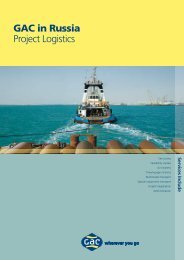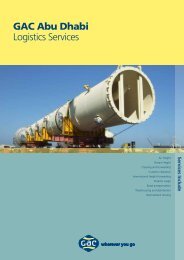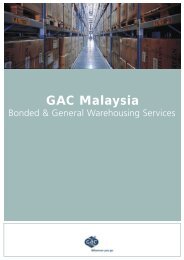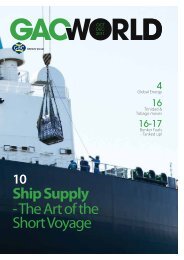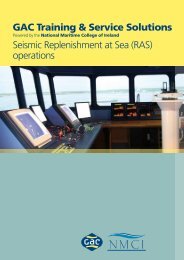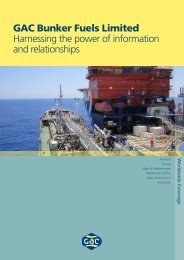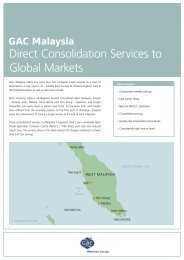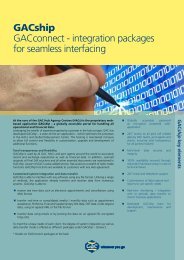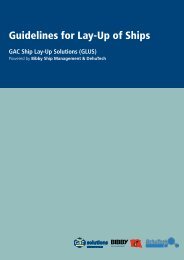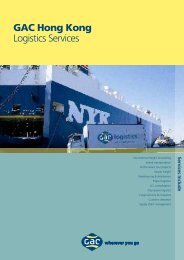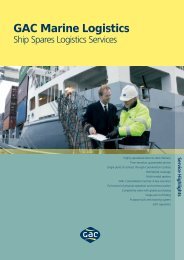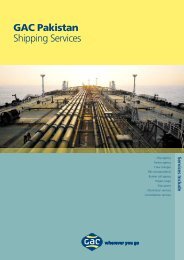You also want an ePaper? Increase the reach of your titles
YUMPU automatically turns print PDFs into web optimized ePapers that Google loves.
No 3 July 2005<br />
For professionals in shipping, transport and logistics<br />
The Subcontinent<br />
– Accelerating
2 Editorial<br />
Subcontinental Contradictions…<br />
The Indian Subcontinent: it’s a phrase that<br />
reveals and conceals – one part defi nition<br />
and two parts deception.<br />
The Oxford English Dictionary defi nes<br />
the word subcontinent as “a large land mass<br />
smaller than a continent”. So much for the<br />
defi nition; the deception lies deeper, hid-<br />
den more in the character of the land and<br />
its people.<br />
The Subcontinent contains the world’s<br />
tallest peaks, harsh wastelands, temperate<br />
climes and tropical forests. You can fi nd<br />
heart-breaking poverty and incredible<br />
riches side-by-side; lose yourself in a sea<br />
of humanity in Delhi or Karachi, or stand<br />
in the middle of Rajastan with no sign of<br />
life for miles around.<br />
Diversity of land and of people: India<br />
alone recognises 22 offi cial languages and<br />
845 dialects. It is a land of ancient faiths<br />
that either embrace or ignore the trim-<br />
mings of modernity. It is a high-tech/low-<br />
tech region, a place where the ox cart and<br />
the satellite share equal billing, where the<br />
power of technology and the power of<br />
prayer are both celebrated.<br />
Dictated<br />
For more than twenty years <strong>GAC</strong> has<br />
been part of this rich mixture, growing<br />
and changing as the times have dictated. In<br />
the pages that follow, you will read about<br />
what we are up to in India, Pakistan and Sri<br />
Lanka and glimpse the range of activities<br />
we have developed in this fascinating – and<br />
sometimes frustrating – region.<br />
Its very diversity has a habit of creating<br />
challenges, either natural or man-made. At<br />
<strong>GAC</strong> we have a tradition of overcoming<br />
the odds.<br />
A case in point is the way our Sri Lanka<br />
team responded to the December 2004<br />
tsunami (page 10). Another is the way<br />
we are managing the infrastructure chal-<br />
lenges of the transit trade into Afghanistan<br />
(page 12).<br />
You…<br />
Both in the Subcontinent and around the<br />
world, we are nothing without you – our<br />
customers. We have given concrete rec-<br />
ognition to your importance through our<br />
commitment to Customer Relationship<br />
Management (CRM). CRM puts you at<br />
the centre of everything we do. You will<br />
meet our CRM team on page 20.<br />
Lars Peter<br />
Heisselberg,<br />
Editor<br />
larspeter.heisselberg@gacworld.com
14<br />
China – World Factory<br />
and a New Consumer<br />
Power<br />
<strong>GAC</strong>s' Capt. Bi Yu Ping at the Connecticut<br />
Maritime Association (CMA) annual<br />
shipping conference<br />
Editorial information<br />
Editor: Lars Peter Heisselberg,<br />
Gulf Agency Company Ltd,<br />
Jebel Ali, Dubai, United Arab Emirates<br />
Production: Anna Rydén Produktion AB,<br />
Stockholm, Sweden<br />
Correspondence to: Amanda Millen,<br />
TBWA\Athens, 1 Flias Street,<br />
GR-151 22 MAROUSSI, Greece.<br />
Tel +30-210-812 5400,<br />
Fax +30-210-812 5480<br />
E-mail amanda.millen@tbwa.gr<br />
Information quoted in this publication has been<br />
obtained from several sources. Whilst every care<br />
has been taken to ensure that details are correct,<br />
<strong>GAC</strong> cannot provide any guarantees thereof.<br />
Material in this publication may be freely<br />
quoted, provided the source is clearly identified.<br />
Cover photo: Pressens Bild<br />
Contacting <strong>GAC</strong><br />
Want the contact details for a <strong>GAC</strong> offi ce or<br />
staff member? Go to the Direct ory section of:<br />
www.gacworld.com<br />
4<br />
South Asian<br />
<strong>Juggernaut</strong><br />
An Indian Subcontinent brief<br />
<strong>GAC</strong> World No. 3, 2005<br />
10<br />
Galle – Recovering<br />
from the Tsunami<br />
After monster waves smashed through the<br />
port on December 26 last year, an intense<br />
salvage operation followed for <strong>GAC</strong>’s Sri<br />
Lankan Ship Supply Service.<br />
Editorial: Subcontinental Contradictions… Page 2<br />
The Indian Subcontinent –<br />
South Asian <strong>Juggernaut</strong> Pages 4 – 9<br />
First Person Report from Sri Lanka: Recovering from the Tsunami Page 10<br />
Insight: Transit Trade to Rebuild Aghanistan Page 12<br />
News Beat Page 14<br />
<strong>GAC</strong> Spotlights China at CMA Page 14<br />
<strong>GAC</strong> Wrap Pages 16 –18<br />
My Town: Sherine Sherif's guide to Cairo Page 19<br />
Wherever You Go: <strong>GAC</strong>'s global Customer Relationship Management team Page 20
4 Hub Agency Services<br />
The Indian Subcontinent:<br />
South Asian<br />
<strong>Juggernaut</strong><br />
‘<strong>Juggernaut</strong>’ is one of the names of the Hindu god Krishna, a Sanskrit word<br />
meaning, ‘Lord of the World’. It also describes an unstoppable force. It is<br />
thus a completely appropriate term for the economic and social progress<br />
being made in recent times in the Indian subcontinent.<br />
From the peaks of the Himalayas to the<br />
tropical tip of Sri Lanka, the subcontinent<br />
encompasses more than 1.4 billion people<br />
and almost every extreme of climate and<br />
terrain.<br />
This vast area stretching from the Afghan<br />
frontier to Burma was subject to foreign rule<br />
from the early 1800s until the demise of the<br />
British Raj in 1947.<br />
Since the late 1980s, when India, Pakistan<br />
and Sri Lanka began to open up to economic<br />
reform and foreign investment, a burgeoning<br />
middle class has developed, prompting a rise<br />
in domestic demand. Great strides have also<br />
been made in a number of fi elds – including<br />
IT – and many native-born professionals are<br />
now returning home to contribute to and<br />
take advantage of these developments.<br />
Progress<br />
Today, the countries that make up the sub-<br />
continent have established their own place<br />
on the international stage, both commer-<br />
cially and politically.<br />
And despite various disputes, the sub-<br />
continent’s main players – India, Pakistan<br />
and Sri Lanka – are making steady progress,<br />
says <strong>GAC</strong>’s Regional Director Christer<br />
Sjödoff.<br />
More than ever, the development focus<br />
is on transport infrastructure to help main-<br />
tain current growth rates. This has helped<br />
improve the means of getting goods to a vast<br />
and increasingly sophisticated consumer<br />
market and also boosted the region’s trade<br />
and tourism.<br />
Growth potential<br />
“After China, the Indian subcontinent is per-<br />
haps the area that offers the greatest poten-<br />
tial for international trade growth – both<br />
for imports to the domestic market and as<br />
an export centre for goods destined for the<br />
rest of the world,” says Christer.<br />
“The opportunities it presents have not been<br />
wasted on the international trade commu-<br />
nity, and we are seeing steady growth in<br />
every sector as a result.”<br />
Demand-driven<br />
<strong>GAC</strong> has long been established in the Indian<br />
subcontinent, and today has extensive offi ce<br />
networks throughout India, Pakistan and Sri<br />
Lanka. Elsewhere, it works with sub-agents<br />
to provide a broad range of shipping and<br />
logistics solutions.<br />
Customer demand has always been the<br />
major driving force. Today, the traditional<br />
shipping agency services that formed the<br />
backbone of <strong>GAC</strong>’s activities in the region<br />
are being joined by a range of new services<br />
including third part logistics, freight, bun-<br />
ker supplies and marine services.<br />
“Logistics offi ces are being opened through-<br />
out the region to accommodate the grow ing<br />
domestic consumer market and in creasing
international trade in a wide range of com-<br />
modities,” says Christer.<br />
“As a leading provider of shipping, logistics<br />
and marine services and solutions in the Indian<br />
Subcontinent, <strong>GAC</strong> is constantly looking for<br />
new ways to enhance its portfolio to better<br />
serve its many clients in the region.”<br />
Human Resource<br />
Within the region’s massive population is a large<br />
pool of educated and skilled professionals - a<br />
driving force behind its development.<br />
<strong>GAC</strong> takes advantage of that resource, com-<br />
bining local and expatriot talent to offer the<br />
best of both worlds. And many professionals<br />
from the region can be found in <strong>GAC</strong> offi ces<br />
worldwide.<br />
Photo: Pressens Bild<br />
Christer adds: “Currently, we have about<br />
1,000 <strong>GAC</strong> professionals working in India,<br />
Pakistan and Sri Lanka. That fi gure will rise as<br />
new offi ces and services are added in response to<br />
the demands of the region’s diverse markets.”<br />
The Indian Subcontinent<br />
Regional Agreement<br />
to Boost Free Trade<br />
In January last year, the South Asia Free Trade Agreement (SAFTA)<br />
was signed at the 12th South Asian Association for Regional<br />
Cooperation (SAARC) summit at Islamabad. This created the framework<br />
for a free trade zone covering 1.4 billion people in India,<br />
Pakistan, Nepal, Sri Lanka, Bangladesh, Bhutan and the Maldives.<br />
The SAFTA agreement will introduce zero customs<br />
duty on trade in practically all products<br />
within the region by the end of 2012.<br />
It is intended that the SAARC Preferential<br />
Trading Arrangement (SAPTA), which provides<br />
for concessional duty on sub-continent trade,<br />
will make way for SAFTA at the beginning of<br />
2006. The new agreement will become opera-<br />
Bangladesh<br />
Bangladesh came into existence when Bengali<br />
East Pakistan separated from West Pakistan in<br />
1971. It is located between India and Burma,<br />
bordering the Bay of Bengal. Natural hazards<br />
include frequent droughts and cyclones.<br />
Total area: 144,000 square kilometres<br />
Coastline: 580 kilometres<br />
Population: 44,319,628<br />
Main exports: Garments, jute & jute goods,<br />
leather, frozen fi sh & seafood.<br />
Main imports: Machinery & equipment,<br />
chemicals, iron and steel,<br />
textiles, foodstuffs,<br />
petroleum products, cement.<br />
Ports & harbours: Chittagong, Dhaka, Mongla<br />
Port, Narayanganj<br />
The Maldives<br />
This low-lying group of atolls south-southwest<br />
of India in the Indian Ocean was among<br />
the nations to be hit by the December 2004<br />
tsunami. Tourism in the Maldives’ largest<br />
industry, representing more than 60% of<br />
foreign exchange receipts and over 90% of<br />
government tax revenue.<br />
Total area: 300 square kilometres<br />
Coastline: 644 kilometres<br />
Population: 349,106<br />
Main exports: Fish, clothing.<br />
Main imports: Petroleum products, ships,<br />
foodstuffs, textiles, clothing,<br />
intermediate and capital<br />
goods.<br />
Ports & harbours: Gan, Male.<br />
Nepal<br />
Nepal is a mountain kingdom in the<br />
Himala yas, bordering China and India.<br />
It contains eight of the world’s highest<br />
peaks including Mount Everest.<br />
Total area: 140,800 square kilometres<br />
Population: 27,676,547<br />
Main exports: Carpets, clothing, leather<br />
goods, jute goods, grain.<br />
Main imports: Gold, machinery &<br />
equipment, petroleum<br />
products, fertilizer.<br />
5<br />
tional after ratifi cation by the governments of<br />
all seven signatory nations.<br />
Under SAFTA, the subcontinent’s three<br />
main developing countries – India, Pakistan<br />
and Sri Lanka – will be required to bring duties<br />
down to 20% in the fi rst phase of the two year<br />
period ending in 2007. In the fi nal phase ending<br />
in 2012, that duty will be reduced to zero<br />
in a series of annual cuts.<br />
Bhutan<br />
This landlocked country is strategically<br />
located between China and India and<br />
controls several key Himalayan mountain<br />
passes. Its name means “Land of the<br />
Thunder Dragon” and is derived from violent<br />
storms in the Himalayas.<br />
Total area: 47,000 square kilometres<br />
Population: 2,232,291<br />
Main exports: Electricity (to India),<br />
cardamom, gypsum, timber,<br />
handicrafts, cement, fruit,<br />
precious stones, spices.<br />
Main imports: Fuel & lubricants, grain,<br />
machinery & parts, vehicles,<br />
fabrics, rice.<br />
Enquiries concerning Bangladesh, Bhutan,<br />
the Maldives and Nepal should be directed<br />
to <strong>GAC</strong>’s Asia Pacifi c/Indian Subcontinent<br />
Regional Offi ce in Singapore at<br />
christer.sjodoff@gacworld.com<br />
Read on for more about the region’s<br />
major players – India, Pakistan and Sri Lanka. >
6 The Indian Subcontinent<br />
India:<br />
Big Country, Big Market<br />
– Bigger Potential<br />
Photo: Pressens Bild
India’s economy is the fourth largest in the world and growing fast.<br />
It is worth USD 600 billion and is set to have a huge impact on global<br />
trade. Exports have clocked up annual growth of more than 15% in the<br />
past two years, industrial output growth is estimated at 7 – 9%, and the<br />
services sector has expanded by 8% in the past year.<br />
Trade liberalisation, greater competition,<br />
freer foreign investment policies and an<br />
ambitious trade policy which aims to<br />
double India’s share of global merchandise<br />
trade by 2009, have secured Indian manu-<br />
facturers an expanding slice of global mar-<br />
kets. It is, in short, a promising economy<br />
backed by a skilled workforce.<br />
Low cost country<br />
‘Made in India’ could become the next big<br />
export success story, as the trend to man-<br />
ufacture and source products in low cost<br />
countries gathers momentum, particularly<br />
in skill-intensive industries where India<br />
has a competitive advantage.<br />
Multinational manufacturers of auto-<br />
mobiles, phamaceuticals and capital<br />
goods were among the fi rst to recognise<br />
this opportunity and have set up bases in<br />
India, lighting a beacon that looks set to<br />
draw in other commercial sectors.<br />
So, it is no surprise that India is the<br />
fourth largest oil consumer in the Asia-<br />
Pacifi c region. Since it began deregulat-<br />
ing its oil and gas markets, consumption<br />
has doubled and further growth is anti-<br />
cipated.<br />
Celebrated<br />
<strong>GAC</strong> India recently celebrated 20 years<br />
of doing business in this key market. From<br />
one offi ce in the port of Cochin, the com-<br />
pany has built a network of offi ces to<br />
provide shipping and logistics services<br />
covering all major ports and key logistics<br />
locations. It now employs more than 250<br />
people. More offi ces are planned.<br />
Port coverage<br />
With such an extensive network in place<br />
<strong>GAC</strong> India expects to handle 1,000 port<br />
calls by the end of 2005.<br />
In response to the growth of the coun-<br />
try’s oil and gas sector, the company has<br />
opened an offi ce in Hazira to handle Shell’s<br />
shipments.<br />
On the liner front, <strong>GAC</strong> India has long<br />
focused on delivering agency services for<br />
container line Principals and break bulk<br />
liner operators, and has full liner teams in<br />
place in Mumbai, Delhi, Kolkata, Chennai<br />
and Cochin.<br />
Other projects include the planned intro-<br />
duction of bunkering services, a new con-<br />
tainer yard, and expansion of the <strong>GAC</strong> glo-<br />
bal network of P&I Club Representatives.<br />
Logistics unleashed<br />
Another expanding area is logistics.<br />
“We are currently extending services<br />
with new bases at Delhi, Kolkata, Tuticorin,<br />
Tirupur and Bangalore and more to follow<br />
in the coming months,” says <strong>GAC</strong> India’s<br />
Managing Director Paul Haegeman. “We<br />
are also looking into introducing logistic<br />
services in other places where we have pre-<br />
viously focused on shipping.<br />
The Indian Subcontinent<br />
7<br />
“By offering an integrated portfolio of ship-<br />
ping and logistics services, we provide a<br />
more comprehensive and well-rounded<br />
service to our many varied clients through-<br />
out the country.”<br />
This year brings a number of new<br />
logistics products including the launch<br />
of <strong>GAC</strong>Sure (<strong>GAC</strong>’s tailor-made insur-<br />
ance initiative), <strong>GAC</strong>’s own Clearing and<br />
Forwarding operation, IATA-approved<br />
services, and International Moving.<br />
And there will be further expansion<br />
and penetration of new markets. Weekly<br />
consolidations to New York, UK and Eu-<br />
rope are now under active consideration.<br />
New investment<br />
– Old Advantage<br />
Paul Haegeman says the plans for the future<br />
show how seriously <strong>GAC</strong> takes the oppor-<br />
tunities offered by the Indian market.<br />
“New investment is being made in<br />
personnel, training and marketing to<br />
secure the expertise to provide top-<br />
notch services and achieve a high profi le<br />
as a major player on the Indian scene,” he<br />
says. ”<strong>GAC</strong> has the advantage of being<br />
resident in India for a long time. We<br />
came here when things were quiet and<br />
we’ve built our services in step with the<br />
changes and growth patterns around us.<br />
We know this country and we know how<br />
to serve the needs of people wanting to do<br />
business here.”
8 The Indian Subcontinent<br />
Pakistan:<br />
Lion about to Roar<br />
Strong fundamentals coupled with international support are trans-<br />
forming Pakistan into a modern and progressive economy.<br />
Figures for 1999-2004 show reductions<br />
in fi scal defi cit, expenditure and foreign<br />
debt. Earnings, foreign exchange reserves,<br />
exports and revenue collection have all<br />
increased.<br />
Economists now view Pakistan as a<br />
strong, vibrant economy, and foresee<br />
average annual growth rate of 7-8% over<br />
the next decade. Agriculture, small and<br />
medium-sized enterprises, housing and<br />
construction, oil and gas, IT, tourism and<br />
telecommunications have all been identi-<br />
fi ed as areas pivotal to that growth.<br />
From 2 to 365+<br />
When <strong>GAC</strong> started in Pakistan two dec-<br />
ades ago, it had just seven staff at its<br />
Karachi offi ce and handled two ships in<br />
its fi rst year.<br />
The company is now Pakistan’s leading<br />
shipping enterprise, handling more than<br />
365 calls per year at Karachi, Port Qasim,<br />
Gadani and Gwadar, and employs more<br />
than 600 people.<br />
It is also expanding as a logistics provider,<br />
drawing on the <strong>GAC</strong> Group’s internation-<br />
ally recognised expertise in the fi eld.<br />
Container handling – in port and beyond<br />
– represents an important area of activity,<br />
with 20% growth witnessed in recent years<br />
and an annual throughput of about 1.3 mil-<br />
lion TEUs. <strong>GAC</strong> Pakistan is a leading player,<br />
and represents some of the world’s leading<br />
container lines. In response to increasing<br />
demand the company has opened offi ces<br />
at fi ve inland locations.<br />
Central Asia<br />
<strong>GAC</strong> Pakistan is playing a leading role<br />
in the development of the new port of<br />
Gwadar in the south-west of the country,<br />
to facilitate transit trade to Afghanistan<br />
and other land-locked Central Asia states<br />
(see Insight on page 12).<br />
<strong>GAC</strong> has handled shipments of con-<br />
struction materials and an oil drilling rig<br />
operating off Gwadar port and is devel-<br />
oping prospects for transit trade once the<br />
port’s second phase is ready to start full<br />
operations in 2007.<br />
Integrated – extensive<br />
<strong>GAC</strong> Pakistan seamlessly links its shipping<br />
services to a wide array of logistics serv-<br />
ices through a network of offi ces at loca-<br />
tions including Karachi, Lahore, Faislabad,<br />
Islamabad, Multan and Sialkot. More loca-<br />
tions are likely to be added.<br />
This combination of shipping and<br />
logistics services gives a total solution<br />
to Principals’ transportation challenges,<br />
both in the domestic market and for tran-<br />
sit cargo to and from Central Asia. It also<br />
plays an important role in supporting<br />
Principals involved in offshore operations<br />
such as oil exploration.<br />
Investing in future<br />
Capt. Javed Iqbal, Director, Shipping<br />
Services in <strong>GAC</strong> Pakistan, says the Gwadar<br />
Port project and positive developments in<br />
Pakistan-India relations, will deliver mas-<br />
sive boosts to trade in the country.<br />
“These represent signifi cant opportu-<br />
nities, and <strong>GAC</strong> Pakistan will invest con-<br />
siderably in the country’s future,” he says.<br />
“Not least, we will continue expanding our<br />
role in Gwadar and the rollout of our logis-<br />
tics network to meet all the demands of<br />
our Principals as Pakistan trade grows.”<br />
Al-Hamd International<br />
Container Terminal<br />
Since 2001, <strong>GAC</strong> Pakistan has been<br />
run ning the Al-Hamd International<br />
Con tainer Terminal (AICT) near<br />
Karachi port, in a joint venture with<br />
local partners.<br />
Photo: Pressens Bild<br />
The terminal, an 18 acre Container Yard<br />
including a 3,000sqm CFS (Container<br />
Freight Station), handles 4,000 TEUs per<br />
month, a fi gure that will increase as the<br />
economy grows.<br />
AICT acts as a hub for FCL (Full Container<br />
Load) containers arriving from Port<br />
Qasim. Every day well over 100 con tainers<br />
arrive for onward delivery to im porters.<br />
Plans are being laid for the launch of a<br />
consolidation service for export cargo containers<br />
and the introduction of a complete<br />
third party logistics services.
It is small in size and population – about<br />
65,000 square kilometres of land<br />
and less than 20 million inhabitants.<br />
However, Sri Lanka plays an important<br />
regional role due to its location close to<br />
major Indian Ocean sea routes.<br />
Like a teardrop laid upon the waters, the<br />
island has been a key location for interna-<br />
tional shipping since the late 1400s, when<br />
Portuguese navigators fi rst found a sea<br />
route around southern Africa. Its signif-<br />
icance for world trade is refl ected in its<br />
history of foreign rule by the Portuguese,<br />
Dutch and British, until it gained inde-<br />
pendence in 1948.<br />
Vibrant<br />
Today, despite internal disputes and<br />
recent natural disasters, the country is a<br />
major centre for growth and development.<br />
Indeed, Sri Lanka is one of the region’s<br />
most vibrant economies and its GDP is<br />
expected to grow by 5.4% this year.<br />
Traditional industries remain strong.<br />
Tea, rubber, coconut and spice planta-<br />
tions were established by the British more<br />
than a century ago to take advantage of<br />
Sri Lanka’s fertile soil and benign climate.<br />
Tea remains the country’s major foreign<br />
exchange earner.<br />
However, the focus is now on new<br />
industries like food processing, textiles,<br />
manufacturing, insurance and banking.<br />
Volume garments are the country’s larg-<br />
est export commodity. Services, and the<br />
all-important tourism trade, also play a<br />
signifi cant role.<br />
Enterprise philosophy<br />
For the past 12 years, <strong>GAC</strong> has been a lead-<br />
ing force in Sri Lanka’s shipping sector, pro-<br />
viding a full range of services to vessels<br />
at its major ports of Colombo, Galle and<br />
Trincomalee.<br />
Following the recent addition of two<br />
boats – OMS I and OMS II – <strong>GAC</strong> now<br />
owns and operates a fl eet of six craft serv-<br />
ing shipping at Colombo and Galle.<br />
In 1994, <strong>GAC</strong> set up Sri Lanka’s fi rst<br />
Ship Supply Service (SSS) base in Galle to<br />
serve vessels plying the major trade routes<br />
to the south of the country. Last year the<br />
Galle SSS team handled about 365 supply<br />
and crew changes.<br />
Bunkers<br />
In March this year, an important serv-<br />
ice was added, with the opening of the<br />
<strong>GAC</strong> Bunker Fuels (<strong>GAC</strong>BF) Sri Lanka<br />
offi ce serving ships calling at Colombo<br />
and Galle.<br />
<strong>GAC</strong> Wrap<br />
Sri Lanka:<br />
Strategic Pearl<br />
This was a natural expansion, as <strong>GAC</strong><br />
is now one of the country’s foremost ship-<br />
ping agents, logistics providers and off-<br />
shore marine services contractors.<br />
Logistics<br />
9<br />
<strong>GAC</strong> Sri Lanka provides a wide range of spe-<br />
cialised country-wide logistics services.<br />
Commodities handled are diverse and<br />
include Sri Lanka’s most famous export<br />
– tea. Since 2001, <strong>GAC</strong> has handled the<br />
clearing and shipping of about 12 million<br />
kg of tea per year for Unilever.<br />
Container hub<br />
More recently, <strong>GAC</strong> has introduced weekly<br />
FCL (Full Container Load) and LCL (Less<br />
than full Container Load) liftings from<br />
Colombo to Male in the Maldives.<br />
<strong>GAC</strong> Colombo has established a Multi-<br />
country Consolidation (MCC) facility and,<br />
thanks to competitive on-carriage tariffs,<br />
the port is now used as the <strong>GAC</strong> global<br />
network’s cargo transhipment hub for<br />
ports throughout the Indian subcontinent.<br />
Colombo is also the regional hub for LCL<br />
cargo for <strong>GAC</strong> Bahrain’s personal effects/<br />
commercial cargo consolidation service for<br />
worldwide destinations.<br />
Marine<br />
Photo: Pressens Bild<br />
Since 1999, <strong>GAC</strong> has been contracted as<br />
Marine consultants for Shell Gas Lanka<br />
Limited Marine Management. Operations<br />
on behalf of the client include pilotage,<br />
mooring and un-mooring, serving gas tank-<br />
ers calling at an offshore CBM (conventional<br />
buoy mooring) and CBM maintenance.
10 First Person Report from Sri Lanka<br />
Recovering from the Tsunami<br />
Without precedent<br />
“When the two massive waves hit the coast on<br />
December 26, the devastation they wrought<br />
was without precedent.<br />
The fi rst wave raised the water level in the<br />
harbour by a metre and broke our supply vessels<br />
“<strong>GAC</strong>SHIP I” and “<strong>GAC</strong>SHIP II” from their<br />
moorings.<br />
About 20 minutes later, another monster<br />
wave struck, sweeping the boats 500 metres<br />
inland where they came to rest in front of<br />
the Port Manager’s offi ce. The water just<br />
kept on going, destroying everything in its<br />
path, including the <strong>GAC</strong> Galle offi ce parapet<br />
wall. Inside the offi ce, the fl ood waters rose<br />
to within a foot of the ceiling and our local<br />
Manager’s home was also fl ooded.<br />
Immediate response<br />
As soon as news of the disaster reached us in<br />
Colombo, we scrambled to contact our Galle<br />
colleagues to make sure everyone was safe<br />
and to assess the impact on the SSS base. It<br />
was no easy task as the entire island had been<br />
thrown into chaos and telephone contact with<br />
Galle proved virtually impossible with all networks<br />
jammed.<br />
An emergency relief team was put together<br />
and set off for Galle with drinking water, dry<br />
rations, clothes and fi rst aid supplies. Upon<br />
arrival, the team gathered most of our local<br />
staff at a colleague’s home where they distributed<br />
relief supplies. Fortunately, none<br />
of the <strong>GAC</strong> Galle team lost their lives and<br />
injuries were relatively minor. However, some<br />
colleagues lost loved ones and also property.<br />
Our immediate focus was on supporting<br />
the humanitarian relief effort and making<br />
arrangements to continue our Ship Supply<br />
Service. The <strong>GAC</strong> service out of Galle had to<br />
be suspended, but we quickly made arrangements<br />
to cater for crew changes, delivery of<br />
spares and other emergency requirements off<br />
port limits at Colombo.<br />
Serious damage<br />
When we started assessing the material damage<br />
to our base and equipment at Galle, a<br />
depressing picture emerged.<br />
Both “<strong>GAC</strong>SHIP I” and “<strong>GAC</strong>SHIP II” had<br />
sustained damage to their engines, propellers,<br />
shafts and hulls; two of our storage containers<br />
had been washed away (later to be discovered<br />
in a ditch 15 metres away); and no trace<br />
could initially be found of the 1,200 kg spare<br />
boat engine which had been stored near the<br />
containers.<br />
After two days’ search, including the use<br />
of divers, we fi nally found the missing engine<br />
buried under a pile of rubble and sand in<br />
the ditch.<br />
Stretched resources<br />
The biggest task we then faced was salvaging<br />
the supply boats. With resources available<br />
in the country stretched to breaking point, it<br />
seemed like a mission impossible at fi rst.<br />
The Sri Lankan port of Galle was one of<br />
the areas hard hit when a massive earthquake<br />
off the coast of Sumatra triggered a<br />
tsunami in the Indian Ocean on December<br />
26 last year. An unstoppable surge of water,<br />
in two separate waves, swept away much<br />
of the port infrastructure and damaged<br />
two of <strong>GAC</strong>’s supply craft stationed at its<br />
Ship Supply Service (SSS) base.<br />
Preethilal Fernando, <strong>GAC</strong> Sri Lanka’s<br />
Managing Director, describes the impact<br />
and the recovery.<br />
Another team was formed in Colombo to<br />
coordinate that challenging recovery operation.<br />
The boats were lifted in place and work<br />
started to restore them to their previous condition.<br />
When it became clear that the repair<br />
and replacement of the propellers would take<br />
longer than expected, it was decided to drydock<br />
them and one of our Master Mariners<br />
was temporarily stationed in Galle to oversee<br />
the work.<br />
When the recovery process started, the<br />
area in front of the Port Residence Manager’s<br />
offi ce resembled a mini dry-dock. Thanks to<br />
the cooperation we received from the Galle<br />
Port Authority, all the repairs were completed<br />
within 6 weeks, despite the apparently impossible<br />
situation we found in the immediate<br />
aftermath of the tsunami.<br />
Transporting the boats presented another<br />
challenge, as there were simply no trailers<br />
available anywhere in Sri Lanka that could<br />
carry a 40 ton, 60 foot long load. But, in the<br />
<strong>GAC</strong> tradition of ingenuity, custom-made<br />
cradles were attached to trailers to accommodate<br />
the load.<br />
Back in business<br />
Thanks to the dedication and hard work of<br />
everyone and in spite of the traumatic experi-<br />
ence they had all gone through, <strong>GAC</strong>’s Galle<br />
Ship Supply Service was back in business by<br />
January 17 – just 21 days after the tsunami<br />
struck.”
First Person Report from Sri Lanka<br />
<strong>GAC</strong>’s President, Capt. Lars Säfverström, reopens the <strong>GAC</strong> Galle offi ce after its recovery from the<br />
devastating tsunami.<br />
Jumbo Lift of<br />
Beached Dredger-<br />
Hopper<br />
Despite the damage <strong>GAC</strong> Sri Lanka<br />
suffered from the tsunami, it also<br />
played a part in assisting other salvage<br />
operations at the port of Galle.<br />
The force of the waves had swept the<br />
840grt, 300 cubic-metre grab hopperdredger<br />
“Diya-Kowulla” out of the sea<br />
and on to the piers at the harbour, leaving<br />
it high and dry.<br />
To get the stranded craft back into the<br />
water, <strong>GAC</strong> Sri Lanka helped arrange for a<br />
specialist heavy-lift ship to come to Galle<br />
The Jumbo Javelin helped in the Galle salvage<br />
operation.<br />
to handle the jumbo lift. And, after an<br />
intensive 48-hour operation in March, the<br />
15,022grt “Jumbo Javelin” hoisted the<br />
“Diya-Kowulla” off the concrete deck of<br />
the jetty and placed her back in the sea.<br />
Despite the stranding, the dredger-hopper<br />
suffered minimal structural damage and<br />
is now back in operation at Galle harbour.<br />
11
12 A Mission for <strong>GAC</strong> Logistics<br />
Insight<br />
Transit Trade to<br />
Rebuild<br />
Afghanistan The<br />
past few years have brought sweep-<br />
ing changes to Afghanistan’s international<br />
trade.<br />
Almost continuously at war for 28 years<br />
until late 2001, Afghanistan is now begin-<br />
ning the slow but steady climb toward a sta-<br />
ble future. Exports and imports are reviving<br />
as the country strives to rebuild.<br />
But Afghanistan is land-locked and so<br />
depends on reliable trade transit routes.<br />
Capt. Ashfaq Ahmed Asim, <strong>GAC</strong> Logistics<br />
Business Manager in Pakistan, takes a look<br />
at the role his country plays in the transit<br />
business.
“Afghanistan is now emerging from a trou-<br />
bled past. People have money once again<br />
and the markets are being fl ooded with an<br />
array of aid, consumer goods, luxury prod-<br />
ucts and imported foodstuffs.<br />
Afghan transit trade has increased four-<br />
fold since 2001 and the latest fi gures show<br />
that import levels rose 150% during the<br />
fi rst two quarters of the current fi scal year<br />
compared to the same period last year.<br />
Though some problems still persist, on<br />
the whole, the outlook looks bright with<br />
the security situation in the capital, Kabul,<br />
being given the “green light” by the United<br />
Nations and new parliamentary elections<br />
due in September.<br />
The fresh air of optimism can perhaps<br />
be felt best in Kabul where new high rise<br />
residential apartments and glass offi ce<br />
towers have already appeared on the city<br />
horizon.<br />
Friendly neighbour<br />
32 countries are participating in rebuilding<br />
Afghanistan, and its neighbour Pakistan is<br />
one of the key players.<br />
Due to its geographical position,<br />
Pakistan is a hub for trade goods mov-<br />
ing to and from the Central Asian states.<br />
Karachi and Port Qasim are the closest<br />
receiving points for sea-borne cargoes<br />
heading to Central Asia. However, this is<br />
nothing new: the fi rst transit agreement<br />
between Afghanistan and Pakistan was<br />
signed in 1956.<br />
Much of the aid and reconstruction<br />
materials sent to Afghanistan since the<br />
fall of the Taleban has come through<br />
Pakistan, and as the domestic economy<br />
fi nds it feet, that transit route is seeing<br />
more and more commercial shipments<br />
heading the same way.<br />
Now, more than ever before, Pakistan<br />
is the main gateway to Afghanistan, and<br />
Pakistani goods have captured almost 60%<br />
of the market.<br />
Good links<br />
Good road and rail links connect the main<br />
ports with the borders of Afghanistan and<br />
Iran.<br />
Pakistan offers a multi-modal transport<br />
system for the Central Asian trade with<br />
extensive services provided by both the<br />
public and private sectors.<br />
To handle expected growth, the Paki-<br />
stan government has made a major com-<br />
mitment to develop a port at Gwadar, 234<br />
miles west of Karachi and 390 nautical<br />
miles from the Strait of Hormuz. Once<br />
operations start at this third deep-sea<br />
port (expected in 2007), Gwadar will<br />
A Mission for <strong>GAC</strong> Logistics<br />
13<br />
become an important centre for trade with<br />
Central Asia.<br />
Meeting challenges<br />
Of course, there are still challenges to be<br />
overcome. Afghanistan’s road network<br />
is poor and there is little regulation of<br />
import and export transit cargo.<br />
Such a situation calls for reliable profes-<br />
sional transit trade service providers like<br />
<strong>GAC</strong> Logistics.<br />
<strong>GAC</strong> Logistics is playing an active role<br />
in Afghan transit trade using our well-<br />
established infrastructure to meet the<br />
challenges involved. Our staff know the<br />
Pakistani transit trade business and what<br />
is required to smoothly execute customs<br />
formalities. Further, all <strong>GAC</strong> Pakistan’s<br />
operations are supported by in-house<br />
state-of-the-art IT systems.<br />
We have already handled transit ship-<br />
ments to Afghanistan for a wide range of<br />
customers, including the United Nations,<br />
aid organisations, construction contrac-<br />
tors, government ministries and a variety<br />
of international trading companies.<br />
In doing so, <strong>GAC</strong> Pakistan has staked<br />
a claim in the growing transit trade to<br />
Afghanistan, and we believe that we will<br />
play a key role in building a brighter future<br />
for the country.”
14 <strong>GAC</strong> Wrap<br />
News Beat<br />
<strong>GAC</strong> Spotlights<br />
China at CMA<br />
When China overtook the USA to become the world’s<br />
top consuming nation in certain commodities in 2004,<br />
it underscored its massive importance to the shipping<br />
industry. That was the message from <strong>GAC</strong> Hong<br />
Kong’s Capt Bi Yu Ping, when he addressed delegates<br />
at the Connecticut Maritime Association (CMA) annual<br />
shipping conference in March this year.<br />
China’s domestic and export economies have<br />
grown spectacularly since the introduction of<br />
its open-door policy in the early 1980s, further<br />
stimulated by entry into the World Trade<br />
Organisation three years ago.<br />
Challenges and opportunities<br />
Speaking on the challenges and opportunities<br />
at major ports in mainland China, Capt. Bi<br />
pointed out that 60% of the China’s import and<br />
export cargo was carried by international shipping<br />
companies.<br />
“China is now the World Factory – a growing<br />
manufacturing and assembly base for many of<br />
the world’s products,” he said.<br />
“It is also a new consumer power, overtaking<br />
the US in 2004 in terms of grain, meat, coal and<br />
steel consumption. And in 2003, China imported<br />
148 million metric tonnes of iron ore, representing<br />
26% of world iron ore trade and overtaking<br />
Japan as the No.1 import country.”<br />
One VLCC<br />
A further indication of China’s growing consumer<br />
demand is <strong>GAC</strong> Hong Kong’s handling an average<br />
of one VLCC (very large crude carrier) per day<br />
in Chinese ports.<br />
In 2004, the country’s GDP was a staggering<br />
USD 1.65 trillion, an increase of 9.5% on the<br />
previous year. Foreign trade reached USD 1.15<br />
trillion, up 35% from 2003, and the total value<br />
of China’s exports last year soared to USD 593<br />
billion, 16 times higher than in 1988.<br />
Capt. Bi said that in the run-up to the 2008<br />
Olympics in Beijing, the growth trend looks set<br />
to continue.<br />
Beyond capacity<br />
However, rapid growth has brought infrastructure<br />
problems. Many of China’s major ports are<br />
working at or beyond capacity and ship waiting<br />
times can range from a couple of days to several<br />
weeks.
Truck and rail services from the ports to inland<br />
areas are overburdened by huge increases in<br />
imported commodities such as iron ore and coal,<br />
but crude oil is piped from ports to refi neries and<br />
thereby avoids the lengthy backlogs that affect<br />
other import cargoes.<br />
Breakthrough<br />
However, the outlook has brightened recently,<br />
said Capt. Bi. The fi rst law passed on port management<br />
since the establishment of the People’s<br />
Republic of China came into force on January 1,<br />
2004.<br />
In effect, that legislation aims to dilute the<br />
Government’s role in the operations and management<br />
of the country’s ports. And, in a breakthough<br />
development, it allows all economic and<br />
individual interests – including those from foreign<br />
companies – to invest in port construction and<br />
management. This will have a long-lasting impact<br />
on port development and management.<br />
Future prospects<br />
Looking to the future, 90% of all China’s foreign<br />
trade will be seaborne – a massive amount<br />
of ocean-going cargo that is expected to hit 4.5<br />
billion metric tonnes by 2010!<br />
The government is now attempting to slow<br />
down economic growth, reducing it to around<br />
8%, with spending goals retreating from “proactive”<br />
to “prudent”.<br />
Top Ten Ports in China 2004<br />
1. Shanghai<br />
Throughput of 379.7 million MT<br />
2. Ningbo<br />
Throughput of 225.9 million MT<br />
3. Guangzhou<br />
Throughput of 215.2 million MT<br />
4. Tianjin<br />
Throughput of 206.2 million MT<br />
5. Qingdao<br />
Throughput of 162.7 million MT<br />
“China is already an economic power, especially<br />
in the maritime arena,” added Capt. Bi.<br />
“Most dry bulk ports are currently struggling<br />
to keep up with the demands due to the country’s<br />
rapid economic development. But if port<br />
management laws are implemented effi ciently<br />
and effectively, sound development in port<br />
operations and management will be seen in the<br />
coming years.”<br />
Final WFP aid shipment to China<br />
A clear sign of China’s impressive economic<br />
growth came in April, when <strong>GAC</strong> handled the<br />
fi nal World Food Programme (WFP) food aid<br />
shipment to the country.<br />
The arrival of the M/V “Blue Dream” carrying<br />
more than 40,000 tons of wheat at the port of<br />
Chiwan was a milestone for the country which<br />
will now become an aid donor after 25 years as<br />
a recipient.<br />
<strong>GAC</strong> Wrap<br />
6. Qinghuangdao<br />
Throughput of 150.3 million MT<br />
7. Dalian<br />
Throughput of 145.2 million MT<br />
8. Shenzhen<br />
Throughput of 134.7 million MT<br />
9. Nanjing<br />
Throughput of 94.9 million MT<br />
10. Suzhou<br />
Throughput of 90.4 million MT<br />
15<br />
<strong>GAC</strong> Hong Kong's Capt. Bi Yu Ping.<br />
The WFP’s Beijing Shipping Offi cer, Wei<br />
Tianrui, says that China is now considered<br />
capable to resolving its poverty problem without<br />
outside assistance and WFP agricultural<br />
development projects there will be phased<br />
out by the end of this year.<br />
The WFP has been sending aid to China<br />
since 1979 and has provided about 3.8 million<br />
tons of food aid to the country over the past<br />
quarter of a century.<br />
<strong>GAC</strong> has handled WFP shipments in the<br />
region since 1996.<br />
The World Food Programme (WFP) sends<br />
aid to developing countries and, increasingly,<br />
to areas affected by natural disasters.<br />
The <strong>GAC</strong> Group represents the WFP in many<br />
countries including: Cambodia, Egypt, Hong<br />
Kong, India, Iran, Iraq, Kuwait, Lebanon, Libya,<br />
Myanmar, North Korea, Saudi Arabia, Syria,<br />
Thailand, Turkey, UAE and Vietnam.
16 <strong>GAC</strong> Wrap<br />
Two Decades and Still<br />
’Less-<br />
Than-<br />
Full’<br />
CargoGulf, <strong>GAC</strong> Logistics’ worldwide<br />
NVOCC (Non Vessel Operating Common<br />
Carrier), is celebrating its twentieth<br />
year of leadership and innovation in<br />
container consolidation and delivery<br />
services across the Middle East, Asia,<br />
Europe and the Americas.<br />
LCL specialist<br />
Established in 1985 in response to growing<br />
demand for transporting small consignments<br />
to, from and within the Middle East,<br />
CargoGulf was a pioneer in sea freight consolidation.<br />
Today, it is internationally recognised<br />
as a global ocean cargo carrier, issuing<br />
Full Box Service Launched<br />
its own Bill of Lading accepted by fi nancial<br />
institutions worldwide.<br />
CargoGulf specialises in the consolidation<br />
of LCL (Less than full Container Loads), using<br />
the reach and strength of the <strong>GAC</strong> global network<br />
to provide a comprehensive service to<br />
major shipping lines and freight companies.<br />
Its services include airfreight consolidations,<br />
customs clearance, transportation, project<br />
cargo and insurance services.<br />
It has, since its inception, surfed the waves<br />
of supply and demand in the LCL market,<br />
riding high in some years and drawing in its<br />
belt in others. TEU (Twenty foot Equivalent<br />
CargoGulf has taken full advantage of the <strong>GAC</strong> Group’s combined<br />
expertise in shipping and logistics to become a vigorous player in the<br />
FCL (Full Container Load) transport industry.<br />
Hans-Henrik Nielsen, Regional Manager,<br />
Freight Services, for Asia Pacifi c and the<br />
Indian Subcontinent, says the Group has<br />
established a service that is more than just a<br />
freight forwarder, logistics provider or liner<br />
agent, representing main line operators in<br />
the traditional sense.<br />
“We are now an FCL operator in our own<br />
right, operating our own fl eet of containers<br />
on long-term leases and arranging purchase slots with 3rd party<br />
feeder operators,” he says.<br />
Market study<br />
A series of market studies in 2004 examined port and depot structures<br />
and cost levels, as well as potential customers.<br />
Based on these fi ndings, the new Cargo Gulf Box Service was<br />
launched, initially focusing on South East Asia and South East Asia<br />
Units) operations have surged three-fold in<br />
the past fi ve years and the momentum is<br />
expected to continue.<br />
Leading NVOCC<br />
“Our customers have played a signifi cant part in<br />
establishing our portfolio of services. It is with<br />
their support that CargoGulf has not only developed<br />
into a leading NVOCC, but has also set a<br />
framework for maintaining our position in the<br />
market,” says General Manager, Peter Orange.<br />
“Many of our business partners have been<br />
with us since CargoGulf’s inception and this is<br />
as much their milestone as it is ours.”<br />
to and from the Indian Subcontinent with participants in Singapore,<br />
Malaysia, Indonesia, Thailand, the Philippines, India, Pakistan and<br />
Sri Lanka.<br />
CargoGulf’s offi ce in Singapore, headed by John Yap, coordinates<br />
all day-to-day operations. John has created a CargoGulf Box Service<br />
manual to clearly explain the product, its working procedures and<br />
the duties of those involved.<br />
Respond innovatively<br />
“We are offering unique benefi ts to our customers,” says Hans-<br />
Henrik.<br />
“These include same agency network in all trade lanes, common<br />
software and communication tools, fast and concise decision-making<br />
as well as commercial freedom to seize initiatives and respond<br />
innovatively to customer needs.<br />
“We are now in the fi rst phase. But who knows where this will<br />
take us? We are only limited by our own imagination!”
Tanker Giant<br />
Signs <strong>GAC</strong><br />
for Ship Spares Logistics<br />
The world’s largest tanker fl eet operator, Stolt-Nielsen<br />
Transportation Group (SNTG), has signed up <strong>GAC</strong> to<br />
handle marine logistics for its entire fl eet transiting via<br />
Singapore and Malaysia.<br />
<strong>GAC</strong> Singapore’s global connections and local<br />
expertise will take care of SNTG’s ship spares<br />
logistics needs, improving vessel turnaround<br />
and reducing costs.<br />
SNTG operates hubs for ship spares consolidation<br />
in Singapore, Houston, Rotterdam and<br />
Durban. The appointment of <strong>GAC</strong> Singapore<br />
is part of SNTG’s long-term objective to<br />
revamp its ship spares logistics operations<br />
worldwide and move towards centralised<br />
ship spares logistics control.<br />
Model hub<br />
Marijn Mos, SNTG Logistics Manager (Purchas<br />
ing & Shipowning), based at the company’s<br />
headquarters in Rotterdam, says tanker<br />
group wanted a logistics partner to provide<br />
warehousing in Singapore, as well as local and<br />
global freight services.<br />
“We wanted a competitive, quality, serviceminded<br />
partner capable of providing high and<br />
effi cient service levels in a time-crucial envi-<br />
Top Awards from Emirates<br />
Emirates Sky Cargo has named <strong>GAC</strong><br />
Dubai its top agent for the past fi nancial<br />
year, recognising the Group’s performance<br />
and long-standing business<br />
relationship with the airline.<br />
ronment,” he says. “What we found in <strong>GAC</strong><br />
Singapore matched that global vision.”<br />
Mr Mos says he is confi dent that the ben- ben-<br />
efi ts in effi ciencies and processes gained from<br />
the Singapore agreement – including clearly<br />
defi ned operating standards and key perform-<br />
ance indicators - can be replicated in SNTG’s<br />
other global hubs.<br />
Focal point<br />
“We are proud to work with SNTG. This deal<br />
is going to help <strong>GAC</strong> take ship spares logis-<br />
tics to an even higher level,” says Kenneth<br />
Bybjerg, <strong>GAC</strong> Singapore’s Logistics Manager.<br />
“This deal reinforces Singapore’s role as a focal<br />
point for marine logistics and port agency<br />
services to ship owners and operators with<br />
bases here.<br />
“The highly specialised ship spares logistics<br />
market has a huge potential for growth. <strong>GAC</strong><br />
Singapore’s business volume for this sector<br />
more than doubled in 2004.”<br />
<strong>GAC</strong> clinched the award thanks to increased<br />
use of the UAE national carrier’s air-freight<br />
services to Europe and the Middle East as part<br />
of its sea-air freight service.<br />
The Top Agent award is part of an annual<br />
portfolio of honours presented by Emirates<br />
Sky Cargo senior management to agents and<br />
<strong>GAC</strong> Wrap<br />
17<br />
couriers in the UAE who signifi cantly contribute<br />
to the airline’s cargo operations.<br />
The award was presented to Paul Lattouf,<br />
<strong>GAC</strong> Dubai’s Business Manager – Freight<br />
Services, at a ceremony at Dubai’s Madinat<br />
Jumeirah hotel on March 16.
18 <strong>GAC</strong> Wrap<br />
Moves and Appointments<br />
Head Offi ce Dubai<br />
Johan Janing as an Accoun t ant, responsible<br />
for Offshore Accounts.<br />
Johan was previously an<br />
Auditor for Lindebergs<br />
Grant Thornton AB in<br />
Sweden.<br />
<strong>GAC</strong> Russia<br />
Valeriy Klimenko as Log ist ics Manager.<br />
Valeriy brings 12 years of<br />
ship ping and forwarding<br />
ex perience to his new post.<br />
He is based in the <strong>GAC</strong><br />
Russia offi ce in the Black<br />
Sea port of Novorossiysk.<br />
<strong>GAC</strong> Dubai<br />
Fredrik Lindblad as Busi ness Manager<br />
– 3PL. Fred rik has 10 years<br />
experience in Log istics<br />
and Business Ad min istration.<br />
He was pre viously<br />
Manager, Busi ness<br />
Develop ment for DHL Solutions,<br />
North ern Europe.<br />
Ronnie Knowles as Business Manager<br />
– Spe cial Projects. Ronnie<br />
over sees the company’s<br />
new facilities projects. Previously<br />
he was Business<br />
Man ager – Distribution<br />
Ser vices in Jebel Ali.<br />
Jean Richmond as In sur ance Admini strator<br />
– <strong>GAC</strong> Logistics, responsible for relations with<br />
the TT Club and HSBC<br />
Insurance Brokers. Jean<br />
pre viously worked for<br />
<strong>GAC</strong> South Africa in Cape<br />
Town.<br />
Pakistan<br />
Henrik Mattila has been appointed as Deputy<br />
Man ag ing Dir ec tor of<br />
<strong>GAC</strong> Paki stan with effect<br />
from May 15, 2005.<br />
Fredrik Nyström, formerly an account ant<br />
at <strong>GAC</strong> in Jebel Ali, joined<br />
<strong>GAC</strong> Pakistan as Financial<br />
Manager on June 1,<br />
2005.<br />
Andhika <strong>GAC</strong> Indonesia<br />
Capt. Boris Nughara as Busi ness Manager<br />
respons ible for the liner,<br />
tanker, tram per and container<br />
busi ness sectors.<br />
– Hi. I'm the new simulation of you, and I'm here to tell you<br />
we won't be needing you anymore."<br />
Marketing<br />
Kristofer Andrén as<br />
Marketing Manager – Shipping<br />
Services, responsible<br />
for Belarus, the Czech<br />
Re pub lic, Denmark, Estonia,<br />
Fin land, Ger many,<br />
Ice land, Lat via, Lithu ania,<br />
Nor way, Po land, West and North west Rus sia,<br />
Slo va kia and Swe den.<br />
Based at <strong>GAC</strong>’s Stock holm offi ce, Kristofer<br />
will take over from Roger Ander son, <strong>GAC</strong>’s<br />
long-stan ding Marketing Manager for the<br />
area, when he retires in the summer.<br />
Sami Younis as Marketing Manager – Shipping<br />
Services, respons ible<br />
for Austria, Bosnia-Herzegovina,<br />
Croatia, France,<br />
Italy, Liechtenstein, Mona<br />
co, Portugal, Serbia-<br />
Mon te negro, Slovenia,<br />
Spain and Switzerland.<br />
Based in London, Sami took over in late<br />
June from Claes Kjellberg, who retires this<br />
summer. Prior to this appointment, Sami was<br />
a broker with <strong>GAC</strong> Bunker Fuels London.<br />
P&I<br />
Adam Greaves as Regi onal Adviser/Consultant,<br />
P&I (Protection<br />
& Indemnity) Claims for<br />
the Middle East. Adam<br />
under takes his new role<br />
in addition to his current<br />
responsi bil i ties as <strong>GAC</strong><br />
Dubai’s Senior Claims<br />
Man a ger, P&I. <strong>GAC</strong>’s P&I net work in cludes<br />
repre sentation of Inter national Group Clubs<br />
throughout the Middle East, West Africa, the<br />
Eastern Mediterranean and the Indian Subcon<br />
ti nent, pro vid ing ser vi ces such as 24/7<br />
claims hand ling, mar ine surveys and damage<br />
reports.<br />
<strong>GAC</strong> World Online<br />
����� ���� �����<br />
������������������������������������������������������<br />
���<br />
�������<br />
������<br />
<strong>GAC</strong> World can be downloaded<br />
as a pdf fi le from the <strong>GAC</strong> website,<br />
www.gacworld.com, where you can<br />
also fi nd previous issues of the magazine.
My Town<br />
The Triumphant City<br />
Cairo<br />
Sherine Sherif’s Guide to<br />
Though born and raised in Alexandria,<br />
<strong>GAC</strong> Egypt’s Bunkering Manager<br />
Sherine Sherif has made Cairo her<br />
home for the past four years. Here,<br />
she offers some tips for visitors to this<br />
fascinating city.<br />
”Historically known as ’al-Qahirah’ (the<br />
Triumphant City), Cairo is one of the world’s<br />
largest urban areas and has much to offer visitors.<br />
It is a cosmopolitan city, full of life and<br />
seems to be on the move 24 hours a day.<br />
Sight-seeing<br />
No trip to Cairo would be complete without a<br />
visit to the Gizah Pyramids – the last remaining<br />
wonder of the ancient world. By visiting the<br />
Pyramids in chronological order, you can see<br />
how their design evolved over the ages.<br />
Memphis, the fi rst capital of ancient Egypt,<br />
is home to a colossal statue of King Ramsis II<br />
as well as the famous Alabaster Sphinx. Not<br />
far away is the Necropolis of Saqqara where<br />
you can see the ruins of the Step Pyramids of<br />
Zoser, the fi rst ever built.<br />
Don’t miss a trip to the Egyptian Museum,<br />
home to some of the world’s most spectacular<br />
antiquities, including the golden treasures<br />
of Tutankhamen.<br />
A trip to The Citadel and Mosques of<br />
Mohamed Ali takes you on an oriental adventure<br />
through part of the medieval Islamic<br />
quarter.<br />
Cairo is also a city of culture, with a wide<br />
array of art galleries and music halls, including<br />
the Cairo Opera House.<br />
Where to stay<br />
Cairo has a wide range of elegant hotels with<br />
very good prices and excellent service.<br />
If you are coming for tourism, the best<br />
place to stay is near the Nile in the centre of<br />
town. But if you are coming on business it is<br />
best to stay close to the companies you will be<br />
visiting in order to avoid the heavy traffi c.<br />
Sherine Sherif with her eight-year-old son, Yahia,<br />
at the Egyptian resort of Sharm El Shiekh.<br />
When not to come<br />
It is better to avoid Cairo between June and<br />
August, as the weather will be extremely hot.<br />
During other months, the weather is usually<br />
very pleasant and we enjoy warm weather and<br />
year-round sunshine.<br />
Best way of getting around<br />
The best bet is probably to hire an air-conditioned<br />
car with a local driver who knows his<br />
way around the city.<br />
Don’t<br />
Don’t try to drive yourself in Cairo - the traffi<br />
c is always very heavy and a local driver is<br />
advisable. Egyptians have their very own way<br />
of driving.<br />
Best shopping<br />
Cairo is a shopper’s paradise. The city offers an<br />
incredible selection, ranging from the famous<br />
Khan el-Khalili souk (bazaar) to modern airconditioned<br />
centres.<br />
All the bounty of the East can be found.<br />
Particularly good buys are spices, perfumes,<br />
gold, silver, carpets, brass and copperware,<br />
leatherwork, glass, ceramics and Egyptian<br />
cotton.<br />
If you decide to go to the souk<br />
in Cairo, you will certainly need<br />
your bargaining skills!<br />
19<br />
Where to eat<br />
Dining on the Nile is a delightful way to spend<br />
an evening. Cruising restaurants offer international<br />
cuisine, often combined with entertainment<br />
like belly dancers and whirling dervishes<br />
– all as you gently fl oat along the river enjoying<br />
some breathtaking views of the city.<br />
Or, you could get a taste of Egypt’s oriental<br />
atmosphere at the Naguib Mahfouz<br />
Restaurant and Café in Khan el-Khalili, where<br />
you can enjoy delicious local specialities and<br />
oriental music against a backdrop of beautiful<br />
Islamic designs.<br />
The Citadel view restaurants and Lakeside<br />
cafés at El Azhar Park are good for lunch or<br />
dinner. This park offers some spectacular<br />
views of historic Cairo’s architectural treasures,<br />
and draws both tourists and city dwellers<br />
to this once-neglected area.<br />
Best thing about the place<br />
Egyptian people are very friendly and generous,<br />
and will always do their best to make you<br />
feel at home. Also, Cairo is a safe city, even<br />
when walking around at night.”
“ After China, the Indian Subcontinent is perhaps<br />
the area that offers the greatest potential for<br />
international trade growth.”<br />
Christer Sjödoff refl ects on the future of the Indian Subcontinent on page 4.<br />
Wherever You Go<br />
XciteU<br />
– Global Focus<br />
on Customer Relationship Management<br />
In January this year, <strong>GAC</strong> launched its “XciteU” Customer Relationship<br />
Management (CRM) Programme, including a series of measures to<br />
ensure that customers remain at the centre of the <strong>GAC</strong> World.<br />
Damien O’Donoghue Mark Delaney John Faulds Daniel Nordberg<br />
CRM involves listening and understanding customers,<br />
anti ci pating their needs, and responding<br />
in a way that ex cites them.<br />
Damien O’Donoghue, the Group’s CRM<br />
Pro gramme Manager, says there is a real commitment<br />
to this initiative.<br />
“It is being addressed whole-heartedly<br />
throughout <strong>GAC</strong>,” he adds. “This is underlined<br />
by our President’s assertion that the<br />
entire Group must understand, embrace and<br />
actively apply the principles of CRM to every<br />
aspect of our business.”<br />
Tools for the job<br />
The numerous CRM programmes already<br />
underway around the world also vouch for<br />
the Group’s commitment to CRM.<br />
These programmes aim to equip a large<br />
proportion of <strong>GAC</strong>’s 6,000 employees with<br />
the tools and expertise to apply CRM to their<br />
work.<br />
In addition to Damien and the four Group<br />
Vice Presidents – Lars Peter Heisselberg (Shipping),<br />
Bill Hill (Logistics), Christer Nordblad<br />
(Marine) and Jan Farnelid (Human Resources)<br />
– key members of the XciteU team driving the<br />
initiative around the <strong>GAC</strong> world are:<br />
• Mark Delaney from <strong>GAC</strong> Marine,<br />
Abu Dhabi<br />
• John Faulds, from <strong>GAC</strong>’s Global<br />
Logistics Team<br />
• Daniel Nordberg, from <strong>GAC</strong>’s<br />
Corporate Head Offi ce in Jebel Ali<br />
Ultimate success<br />
As Damien says, the ultimate success of<br />
the programme will be determined by the<br />
responses of <strong>GAC</strong>’s customers, who will be<br />
the best judges of its effectiveness.<br />
“CRM will encourage our people to look<br />
at our organisation through the eyes of our<br />
customers, and in this way we aim to continuously<br />
improve the services and the value we<br />
offer them.”



